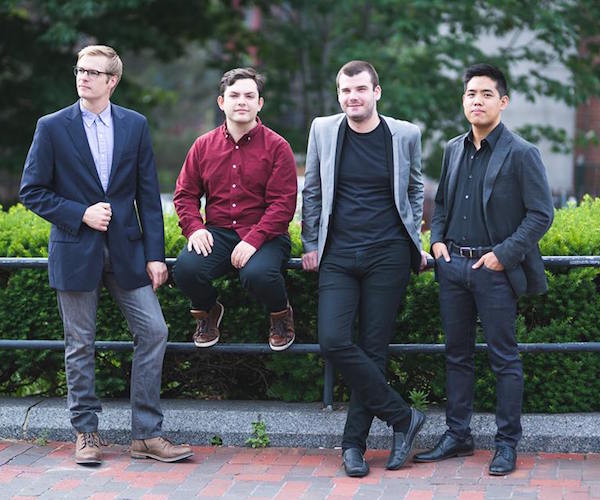Concert Review: Hub New Music in Worcester
A stirring serving of contemporary classical music from Hub New Music.

The members of Hub New Music. Photo: Courtesy of HNM.
By Jonathan Blumhofer
The flute-clarinet-violin-cello ensemble Hub New Music (HBN) brought a short but varied program to Clark University’s Razzo Hall on Sunday afternoon for a kind of pre-Super Bowl contemporary music hit.
The highlight of the program was its biggest piece, Robert Honstein’s Soul House, which received its local premiere. An homage to Honstein’s childhood home in New Jersey, it’s cast in nine movements which are named after various locations in and around the building (“Bay Window,” “Stairs,” “Landing,” Back Yard,” etc.).
If the concept might sound a bit dry or vague, well, the music’s anything but. Honstein’s writing in Soul House is always fresh, sometimes, quite inventive. The textures of the opening movement, “Bay Window,” for one, are beguiling and glassy: string argeggios of harmonics accompany a flute/clarinet melody before the gestures are eventually swapped around. In “Alcove,” a unison wind-and-violin tune falls in and out of synch between the players over a pizzicato cello line. “Backyard” gets an involved, spirited fugue while the property’s stately “Copper Beech” is memorialized with a kind of noble chorale. So is the concluding movement, “Secret Place,” which opens with an undulating, Glass-ian figure before closing in a radiant, nostalgic glow.
HNM played Soul House with terrific panache. There’s some devilishly fun writing to be found in its pages – the swirling arpeggios in “Driveway” are particularly striking – in addition to the ear-catching effects mentioned above (and more). Honstein’s scoring is idiomatic and well-balanced, equal parts athletic and reflective. HNM, for whom it was written, dispatched it with brio.
In his introductory comments, HNM flautist Michael Avitabile described the composition as “a gem.” I can’t think of a better word for it. Let’s hope there’s a recording in the works (or will be soon).
Before the Honstein came three pieces, the last of which was Laura Kaminsky’s The Full Range of Blue, an early-2000s score that began, HNM cellist Jesse Christensen told us, as a meditation on the natural wonders of the Rockies but was completed, post-9/11, in an expressively-changed landscape. Though just one movement (the last, titled “Ash”) alludes to the terrorist attack, the emotional clouds seem to darken by the middle of the work.
The first of Full Range’s six movements opens with Copland-esque gestures that frame a lengthy, lyrical cello solo (played, on Sunday, with warm zeal by Christesen). The second is a bounding, energetic movement called “Slate: Riverbed,” while the third (“Lupines”) provides a static contrast, consisting mainly of short, chromatic phrases passed between the players. There’s a lengthy, often-dissonant violin solo in the fourth movement, “Glacier,” and the fifth, called “Boulder/Avalanche,” frames further solo episodes for flute and cello between sections of boisterous, syncopated rhythms. The pavane-like “Ash” provides a succinct conclusion.
Sunday’s performance nicely brought out the music’s ambivalence, especially the contrasts between its warm, songful writing and the score’s chillier moments. Flautist Avitabile’s ostinatos in “Glacier” were marked by a dark-hued tone and rhythmic precision; so was violinist Zenas Hsu’s solo in that movement. Meanwhile, clarinetist David Dziardziel turned in a lively, well-matched duet with cellist Christesen in “Slate: Riverbed.”
Before The Full Range of Blue came a pair of pieces by Clark faculty members: Sundar Subramanian’s Songs of Friction and Xue Jiang’s Qin Yun.
The former explored various types of sonic abrasion, be they harmonic, rhythmic, or textural. Falling, basically, into three sections, Songs of Friction was the afternoon’s one work that drew regularly on extended techniques (including clarinet multiphonics and singing while playing). They were effective, so far as they went, but never really added up to more than the sum of their parts.
Qin Yun, on the other hand, a virtuoso essay for solo violin, left a stronger impression. It gives the soloist a full workout, with extended, involved pizzicato writing alternating with furious bowed arpeggios, double-stops, and bravura passagework. At times it seems to evoke Ravel’s Tzigane a bit, with a recurring bent-note figure lending a degree of rustic (if not, exactly, gypsy) flavor.
Whatever: it’s hard to imagine a live reading of securer intonation, intensity, and fearlessness than what violinist Hsu turned in. His approach was on the aggressive side, yes, but it was shaped with a strong sense of Qin Yun’s structure and ever alert to the score’s dynamic and melodic nuances.
Jonathan Blumhofer is a composer and violist who has been active in the greater Boston area since 2004. His music has received numerous awards and been performed by various ensembles, including the American Composers Orchestra, Kiev Philharmonic, Camerata Chicago, Xanthos Ensemble, and Juventas New Music Group. Since receiving his doctorate from Boston University in 2010, Jon has taught at Clark University, Worcester Polytechnic Institute, and online for the University of Phoenix, in addition to writing music criticism for the Worcester Telegram & Gazette.
